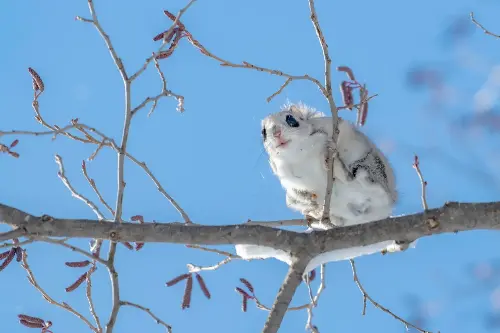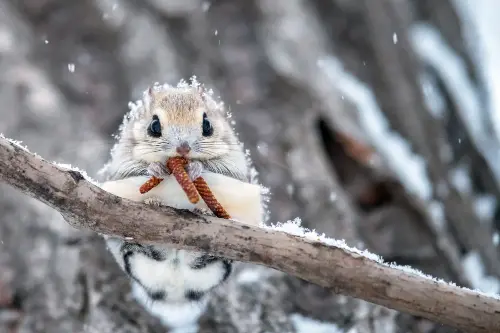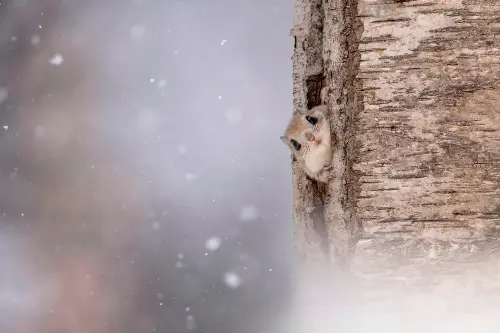The Siberian Flying Squirrel, Pteromys volans, is an enchanting creature that occupies the boreal forests of Europe and Asia. With large, bustling eyes and a fluffy tail, these nocturnal gliders captivate all who catch a glimpse of their aeronautical escapades. But beyond their adorable exterior lies a fascinating life, brimming with intriguing behaviours that make them a marvel of the animal kingdom.

Masters of the Night Sky
As twilight descends upon the forest’s canopy, the flying squirrel awakens, ready to embark on its nocturnal foray. Unlike their terrestrial cousins, flying squirrels do not actually fly but glide, using a special membrane called the patagium. This furry, wing-like structure stretches from their wrists to their ankles and enables them to soar gracefully from tree to tree. With agile manoeuvres, they can alter their trajectory mid-air and execute pinpoint landings with the aid of their sharp claws. The distance they can cover in a single glide is impressive, spanning up to 90 metres, the excellence of this skill nearly akin to an avian feat.
A Charming Socialite
The Siberian Flying Squirrel is not just adept in its aerobatics but also exudes a sociable disposition. During the breeding season, these squirrels exhibit complex courtship rituals, including chittering vocalisations that echo softly through the night air. Yet, their sociability extends beyond the mating period, as flying squirrels have been known to nest communally. Sharing the warmth and companionship of their kind, they huddle together, with several individuals occupying the same tree cavity to brave the cold. This communal living also ensures the safety in numbers, as predators such as owls and martens prowl the night.

Architects of Their Arboreal World
The nests of the Siberian Flying Squirrel are marvels of natural craft. Constructed with deft skill, they repurpose old woodpecker holes, or they might craft their own hollows in the decayed trunks of trees. The furry architects line their abodes with lichen, leaves, and their own velvety fur to create a snug, insulated environment perfect for raising their young. These fortifications not only offer shelter but also serve as strategic launchpads for their nocturnal excursions, flying from treetop to treetop in search of food.
A Diet of Delicate Delights
Speaking of food, the diet of the Siberian Flying Squirrel is a testament to their arboreal lifestyle. These herbivorous critters feast upon a varied menu that includes leaves, seeds, buds, and flowers. In the summer months, they might indulge in the occasional bird egg or even partake in fungi. During the winter, when such luxuries are scarce, they survive on stored reserves of seeds and nuts. Their presence also benefits the forest—as they feed, they inadvertently play a crucial role in seed dispersal, aiding the growth of new trees and underbrush.

Threats and Conservation Efforts
Despite their enchanting presence and beneficial role in the ecosystem, the Siberian Flying Squirrel faces threats from habitat destruction and fragmentation. Logging and urban development curtail the old-growth forests they depend on, reducing their nesting sites and food sources. Thankfully, their plight has not gone unnoticed. Conservation efforts are underway to ensure sustainable forest management that preserves vital habitats. Protected areas are essential for their survival, as well as initiatives to create ecological corridors that link fragmented woodlands, thereby allowing these sprightly squirrels to disperse and thrive.
The Siberian Flying Squirrel, with its undeniable charm, continues to fascinate researchers and wildlife enthusiasts. They remind us of the wonders of the natural world and the myriad ways in which life—even the smallest and most unassuming creatures—adapts and thrives. As we delve into their world, we find a creature deftly balanced between whimsy and wild, demanding our admiration and inspiring a collective effort towards their conservation. The next time the sunset ushers in the calm of evening, imagine the Siberian Flying Squirrels, the silent gliders of the night, leaping into the open air, soaring silently amongst the trees—nature's very own aeronauts, replete with intriguing behaviours and an irresistible charm that are truly one of a kind.
